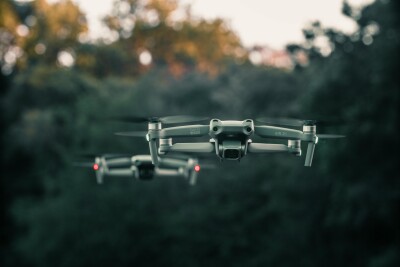Patrick Meier, founder of the Humanitarian UAV Network, kicked off the inaugural edition of the Commercial UAV Expo with a keynote and a request.
He began by noting the great wealth of UAV expertise in the room, calling the attendees experts in the field. The goal of his presentation, he said, was to catalyze partnerships between these industry leaders and existing humanitarian organizations.Why? Humanitarian organizations, Meier explained, need the help of UAV experts to improve the quality of their UAV efforts. They recognize the value of UAVs for purposes like disaster response, but they lack the expertise to put the technology to work in a way that’s effective and safe—expertise, again, well represented in the UAV Expo audience.Meier’s way of accomplishing this goal is through the Humanitarian UAV Network, an organization he founded to “promote the safe, coordinated and effective use of UAVs for data collection, payload delivery and communication services in a wide range of humanitarian and development settings.”The network already has buy-in from an impressive number of humanitarian organizations, including the UN, the World Bank, Unicef, Doctors Without Borders, the American Red Cross. Meier stressed that the network is already serving as an interface between the humanitarian community and technology experts like DJI, Sensefly, and 3D Robotics, so greater success seems to be a matter of getting more experts to contribute.As for how to help out, he mentioned a list of six concrete ways that UAV experts can help out, and maybe even see some ROI in the “drones for good” space.1. TrainingThe Humanitarian UAV Network provides hands-on training to organizations such as FEMA and other UN agencies. Humanitarians are not the experts, Meier stressed again, and they need the help of experts within the space.But it’s not just the humanitarians that can benefit from the training offered by UAV experts. Meier spoke about a Humanitarian UAV Network project in Kathmandu that is attempting to jumpstart a UAV industry within the disaster-prone country of Nepal. There, training is offered directly to the local community, who are then able to complete projects themselves, for instance by deciding on flight plans to gather information necessary for rebuilding after a disaster.“It’s incredibly empowering,” Meier said. He also called projects like these a “huge opportunity” for providers to have their technology and their expertise go a long way.2. GuidelinesThe humanitarian space, like any communities using UAVs, is in the process of developing guidelines for safe and ethical use of UAVs for humanitarian efforts. The Humanitarian UAV Network has the voice of big humanitarian organizations, but Meier says they’re lacking the voice of the UAV industry.3. Strategic ProjectsIn addition to helping shape the use of UAVs for humanitarian work, the UAV industry can contribute to specific projects by offering technology, services, or expertise. For instance, Meier noted, the Humanitarian UAV Network has been working on a project for a crowd-sourced map showing the locations of crises, all with a view to increase situational awareness during disasters. It’s a huge repository of data, Meier noted, and it could benefit from further computer vision research.More simply, the UAV pilots could sign up for a list of available workers when the Humanitarian UAV Network is called on by an organization like the World Bank to respond to a disaster.A huge benefit to UAV operators, Meier noted, is the ability to do very large, very interesting projects. For instance, he explained a very complex project in Australia where humanitarian UAVs were flown in the same space as government airplanes. These projects are not possible where government regulations are holding back work. “If you have a willing government that understands the potential,” he said, “you can do incredible work in the most challenging of circumstances.”4. Experts MeetingsThe network holds meetings of experts within the humanitarian space and the UAV space to discuss, giving them an opportunity to share needs and expertise.5. ResearchMeier explained that there are more questions than there are answers, just as there in other spaces that use UAVs. The humanitarian space would like to research the effect use of 3D models, for instance. “Does the humanitarian space have experience with 3D models?” he asked. “Absolutely not.”6. MediaWe all need positive press, he notes, to highlight the positive uses of UAVs so they are not overshadowed by the “stupidity” of people misusing UAVs.As Meier continually reminded the audience, humanitarian uses are not simply a curiosity, they’re vital applications of this amazing technology. With the help of the UAV Industry, the technology can have real, meaningful social effects.Subscribe
The information you submit will be stored and used to communicate with you about your interest in Commercial UAV News. To understand more about how we use and store information, please refer to our privacy policy.
October 6, 2015
Patrick Meier and Drones for Good




.png.small.400x400.png)











Comments